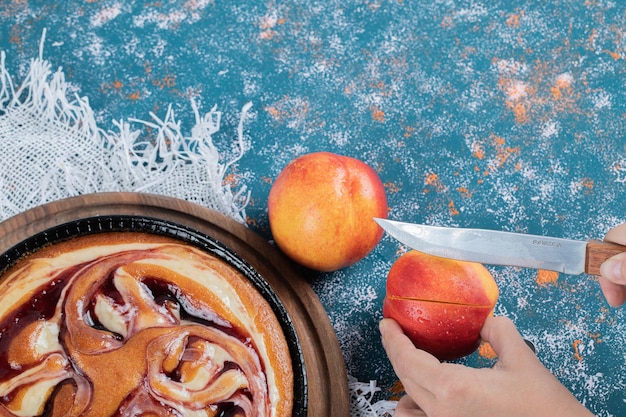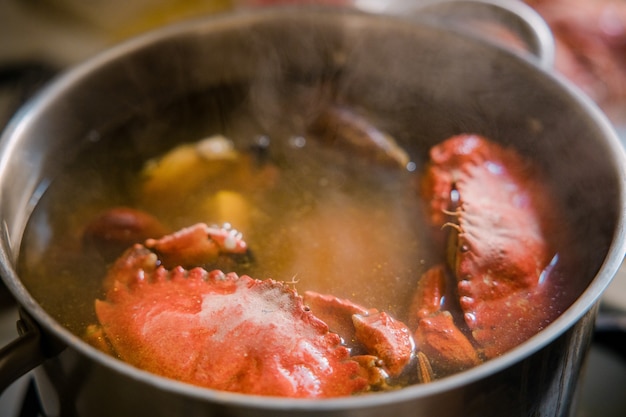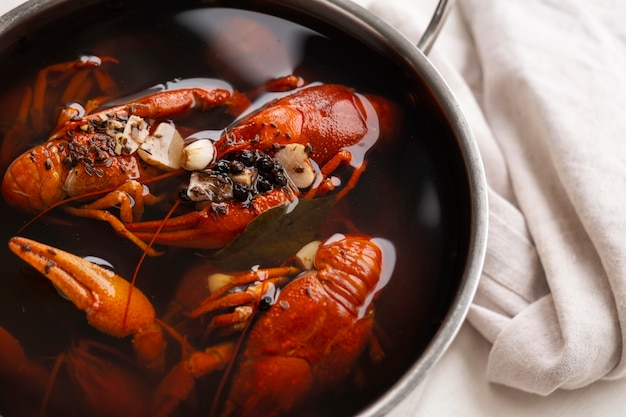Let's face it, there's something undeniably satisfying about cracking open a perfectly cooked lobster and digging into that sweet, succulent meat. It's a real treat, but it can feel a bit intimidating if you're not sure where to start. Fear not, my fellow food enthusiasts! This guide will walk you through every step, from choosing the right lobster to mastering the art of the perfect boil. I'll even share some insider tips and tricks I've learned over the years.
(Part 1) Choosing Your Lobster: The Foundation of a Great Feast

The Lobster Lowdown
Before you even think about cooking, you need to choose the right lobster. It's a bit like picking out a wine - you want something that's going to suit your taste and the occasion. Lobsters are categorized by weight, which is a good indicator of how much meat you can expect. Here's a quick guide to get you started:
Small: 1-1.5 pounds (ideal for a single serving)
Medium: 1.5-2.5 pounds (perfect for two people)
Large: 2.5-3.5 pounds (enough for a small gathering)
Extra Large: 3.5 pounds and up (for a real lobster extravaganza!)
Freshness is King
Always choose a lobster that's lively and active. You want to see that tail curling up, those antennae twitching. If it's sluggish or unresponsive, it might be past its prime.
How to Spot a fresh lobster:
- Shell Appeal: A healthy lobster will have a shiny, dark-coloured shell. Think of it like a freshly polished car – it should gleam!
- Antenna Check: The antennae should be firm and intact. No broken bits or signs of damage.
- Tail Tale: A tightly curled tail is a good sign. It means the lobster is plump and packed with meat.
- The Snap Test: If you gently tap the lobster's body with your finger and it snaps back quickly, that's a good indicator of freshness. It's like a little lobster reflex test!
Where to Shop
You can usually find fresh lobsters at your local fishmonger or supermarket. Ask about their sourcing and how often they receive new deliveries. If you're lucky, you might even find a local lobster pound where you can select your lobster right from the tank.
(Part 2) Getting Your Lobster Ready: The Prep Work

Now that you have your lobster, it's time to get it ready for cooking. Don't worry, this is really quite straightforward. Think of it as a little pre-show warm-up for your lobster.
Essential Tools
You'll need a few basic tools to get the job done. It's like your lobster cooking toolkit!
- A Large Pot: This is crucial for boiling your lobster. It should be big enough to hold the lobster comfortably with plenty of water to spare.
- Sturdy Kitchen Shears: These will be your best friends for cracking open the lobster after it's cooked. Think of them as lobster-cracking superheroes!
- A Sharp Knife: You'll need this if you're splitting the lobster in half for grilling or baking. A good quality chef's knife does the trick.
- A Crab Mallet: If you prefer a more forceful approach to cracking open the lobster, a mallet is a great option. Just remember to wear safety goggles!
- Heat-Resistant Gloves: These are essential for protecting your hands from the hot steam when you're removing the lobster from the pot. Safety first, always!
Preparation Steps:
Rinse It Off: First, give your lobster a good rinse under cold running water to wash away any grit or debris. Think of it as a quick lobster spa treatment.
Secure the Claws: If your lobster is still alive, use a rubber band or string to secure its claws to prevent those pincers from getting pinched. It's all about safety and peace of mind.
Splitting the Lobster: If you're planning on grilling or baking, you'll need to split the lobster in half lengthwise using a sharp knife. This helps the heat penetrate evenly and cook the meat through.
(Part 3) The Art of boiling lobster: The Classic Method

Boiling lobster is the classic and easiest method. It's quick, reliable, and always delivers delicious results.
Setting Up the Boiling Station:
1. Pot of Plenty: Fill your large pot with enough water to completely cover the lobster. We want a nice, luxurious lobster bath!
2. Seasoning Symphony: Add salt to the water to flavour the lobster and help it retain moisture. I usually use about 2 tablespoons of salt per gallon of water, but you can adjust to your taste. You can also add other seasonings like bay leaves, black peppercorns, or lemon slices for extra flavour. It's your lobster symphony, so feel free to improvise!
3. Boiling Point: Bring the water to a rolling boil over high heat. We want that water bubbling and furious!
cooking time:
Lobster Size Matters: Cooking time depends on the size of your lobster. A good rule of thumb is to cook a 1-pound lobster for about 8-10 minutes. For every additional pound, add 2-3 minutes to the cooking time.
For Example:
| Lobster Size | Cooking Time |
|---|---|
| 1 pound | 8-10 minutes |
| 2 pounds | 10-13 minutes |
| 3 pounds | 12-15 minutes |
Checking for Doneness:
Opaque Meat: The best way to check if your lobster is cooked is to pierce the thickest part of the tail with a sharp knife. The meat should be opaque (not translucent) and firm to the touch. It's like a little lobster meat thermometer!
Serving Time:
1. Lobster Retrieval: Use those heat-resistant gloves to carefully remove the lobster from the boiling water. It's hot, so be cautious!
2. Cool Down: Place the cooked lobster on a cutting board and let it cool for a few minutes before you start cracking it open. Patience, my friend!
(Part 4) Other Cooking Methods: Expanding Your Lobster Horizons
Boiling is the classic, but there are other delicious ways to cook lobster. Think of it as venturing beyond the beaten path.
Grilling:
Pre-Grill Prep: Split the lobster in half lengthwise using a sharp knife. Remove the intestinal tract, also known as the "vein", for a cleaner taste. Remember, we want the meat to shine!
Seasoning Time: Season the lobster generously with salt, pepper, and any herbs or spices you love. Garlic powder, paprika, and thyme are my personal favourites. Get creative!
Grilling Time: Grill the lobster over medium heat for about 10-12 minutes per side, until the meat is cooked through and the shell is slightly charred. A little char adds a nice smoky flavour!
Baking:
Oven Prep: Preheat your oven to 400°F (200°C). Grease a baking dish with butter. We want the lobster to glide smoothly into the oven!
Seasoning: Season the lobster with salt, pepper, garlic butter, and your favourite herbs and spices. Don't be shy with those flavour bombs!
Bake Time: Bake the lobster in the preheated oven for about 15-20 minutes, or until the meat is cooked through. You'll know it's ready when it's firm and the shell is slightly pink.
Steaming:
Steamer Setup: Fill the bottom of a steamer pot with water and bring it to a boil. Place the lobster in the steamer basket above the boiling water. Think of it as a little lobster spa treatment.
Steam Time: Steam the lobster for about 15-20 minutes, or until the meat is cooked through. The gentle steam cooks the lobster evenly and keeps it moist.
(Part 5) The Art of Cracking the Lobster: A Masterclass in Extraction
The moment you've been waiting for has arrived! It's time to crack open your beautifully cooked lobster and enjoy the fruits of your labour. Think of it as a lobster treasure hunt!
The Claw Crack:
1. Joint Hunt: Locate the joint where the claw meets the body. You'll see a clear line where the two pieces meet.
2. Cracking Time: Use your trusty kitchen shears or a crab mallet to crack the claw at the joint. You might need to give it a few good whacks! It's all about those satisfying cracks!
3. Extraction: Carefully pull the claw apart to reveal the juicy meat inside. Be gentle, but firm, and you'll be rewarded with deliciousness.
The Tail Crack:
1. The Groove: Locate the groove along the underside of the tail. You'll see a natural line that runs down the centre.
2. Crack it Open: Use your kitchen shears or a crab mallet to crack the tail open along the groove. Use a firm, even pressure to avoid shattering the shell.
3. Release the Meat: Carefully pull the tail meat out in one piece, or gently pry it loose with a fork. It's like a beautiful lobster unfurling!
Extracting the Body Meat:
Body Break: Carefully crack the lobster body in half using your kitchen shears or a crab mallet. Go for a clean, even crack to make meat extraction easier.
Meat Retrieval: Carefully pull the meat out of the body. You might find some smaller pieces of meat around the legs and gills. Don't forget to savor every bit!
Saving the Tomalley:
What is It? Tomalley is the green, creamy substance found in the lobster's head. It's actually the lobster's liver and pancreas, and some consider it a delicacy. It's like a little lobster secret treasure.
How to Use It: You can spread it on toast, mix it into your favourite pasta dish, or even use it as a sauce for grilled lobster. Get creative and explore its flavour potential!
(Part 6) lobster recipes: Beyond the Basics
Once you've mastered the basic cooking techniques, it's time to get creative! Think of this as your lobster recipe playground.
lobster mac and cheese:
Ingredients: Cooked lobster meat, macaroni pasta, cheese sauce (melted butter and flour, milk, your favourite cheeses), salt, pepper, and any other desired seasonings. Think of it as a lobster upgrade for your classic mac and cheese.
Instructions: Prepare the cheese sauce by melting butter and flour in a saucepan, then gradually whisking in milk. Season with salt and pepper and add your favourite cheeses. Stir until the cheese is melted and smooth. Add cooked lobster meat and macaroni pasta to the cheese sauce and stir to combine. Serve hot and enjoy the cheesy lobster goodness!
lobster bisque:
Ingredients: Cooked lobster meat, butter, onions, carrots, celery, flour, milk, heavy cream, salt, pepper, cayenne pepper, and lobster stock (optional). This is a luxurious and flavourful soup that will transport you to culinary heaven!
Instructions: Sauté onions, carrots, and celery in butter until softened. Add flour and cook for a few minutes, stirring constantly. Gradually whisk in milk and heavy cream until the mixture is smooth and thick. Season with salt, pepper, and cayenne pepper to taste. Add cooked lobster meat and lobster stock (if using), and simmer for about 10 minutes, or until the soup has thickened. Puree the soup with a hand blender or food processor until smooth. Garnish with a dollop of cream and a sprinkle of fresh herbs before serving.
Lobster Salad:
Ingredients: Cooked lobster meat, mayonnaise, celery, red onion, lemon juice, salt, pepper, and chopped fresh dill. It's a classic, refreshing, and perfect for summer!
Instructions: Combine cooked lobster meat, mayonnaise, celery, red onion, lemon juice, salt, pepper, and dill in a bowl. Mix gently to combine and chill for at least 30 minutes before serving. It's best to chill the salad to let the flavours blend and for a more refreshing experience.
(Part 7) Storing and Leftovers: Making the Most of Your Lobster Bounty
Fresh Lobster Storage: live lobsters can be kept in a cool, moist environment for up to a week. Place them in a refrigerator with a damp cloth covering them to prevent them from drying out. Think of it as giving them a little lobster hibernation!
Cooked Lobster Storage: Cooked lobster should be refrigerated and eaten within 3-4 days. To prevent the meat from drying out, store it in an airtight container with a little bit of the cooking liquid. Think of it as a little lobster spa treatment for leftovers.
Leftover Lobster: A Taste of Heaven:
lobster rolls: Dice leftover lobster meat and mix it with mayonnaise, celery, and your favourite seasonings. Serve on toasted buns. It's like a little lobster getaway on a bun!
Lobster Pasta: Toss leftover lobster meat with your favourite pasta, olive oil, garlic, and Parmesan cheese. A simple and delicious way to use those leftovers!
Lobster Pizza: Top pizza dough with leftover lobster meat, garlic butter, mozzarella cheese, and a sprinkle of fresh herbs. Think of it as a lobster pizza party in your mouth!
(Part 8) FAQs: Answers to Your Lobster Questions
1. Can I Freeze Lobster?
Yes, you can freeze lobster, but it's best to freeze it cooked. Freeze lobster in airtight containers or freezer bags. Thaw it overnight in the refrigerator before eating. Freezing can change the texture slightly, but it's a good way to preserve your lobster bounty!
2. How Long Should I Cook a Lobster?
Cooking time varies depending on the size of the lobster. A good rule of thumb is to cook a 1-pound lobster for about 8-10 minutes, and add 2-3 minutes for every additional pound. Remember, overcooked lobster is rubbery, so don't cook it too long!
3. What Should I Serve with Lobster?
Lobster pairs beautifully with a variety of sides, including corn on the cob, mashed potatoes, asparagus, roasted vegetables, and salads. You can also serve it with a light white wine or a crisp sparkling wine. Get creative and experiment with your side dish pairings!
4. Is it Safe to Eat the Tomalley?
Yes, it's safe to eat tomalley, and some people find it to be a delicious delicacy. However, if the lobster is old or has a strong odour, it's best to avoid eating the tomalley. It's a matter of personal preference, but if it doesn't look or smell right, it's best to err on the side of caution.
5. What's the Best Way to Tell If a Lobster is Cooked?
The best way to check if a lobster is cooked is to pierce the thickest part of the tail with a sharp knife. The meat should be opaque, not translucent. You can also check if the shell is slightly pink and the lobster has a firm feel.
So there you have it, everything you need to know about cooking the perfect lobster. Now go forth and unleash your inner culinary genius! You'll be the envy of all your friends and family with your delicious lobster creations. Just remember to share the love (and the lobster)! Happy cooking!
Everyone is watching

Perfect Rice Every Time: The Ultimate Guide to Cooking Rice
Cooking TipsAs a self-proclaimed foodie, I've always been a bit obsessed with rice. It's the foundation of countless cuisi...

The Ultimate Guide to Cooking Asparagus: Tips, Techniques, and Recipes
Cooking TipsAsparagus. The mere mention of this spring delicacy conjures up images of vibrant green spears, crisp and burs...

Ultimate Guide to Cooking the Perfect Thanksgiving Turkey
Cooking TipsThanksgiving. Just the word conjures up images of overflowing tables laden with delicious food, the scent of r...

Prime Rib Roast Cooking Time Chart: Per Pound Guide
Cooking TipsPrime rib roast. Just the name conjures images of lavish dinners, crackling fires, and hearty laughter. It’s ...

Can You Cook Spaghetti with Gasoline? (The Shocking Truth)
Cooking TipsWe've all seen those crazy internet trends. You know, the ones that make you wonder, "Did someone actually try...
